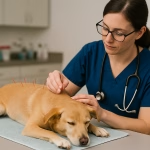
Trusted pharmacist-recommended expectorants to ease chest congestion and improve breathing.
I. Introduction
Chest congestion is one of the most frustrating symptoms people face during a cold, flu, or respiratory infection. That heavy, tight feeling in your chest — combined with the constant urge to cough — can interfere with sleep, work, and even simple daily activities. For many, congestion is more than just an annoyance. When mucus builds up in the airways, it makes breathing harder, increases coughing fits, and prolongs recovery.
As pharmacists, one of the most common questions we hear is: “Which cough medicine should I take for chest congestion?” While the pharmacy aisle is full of colorful boxes and bottles promising relief, not all products are the same. Some are designed to suppress coughs (antitussives), while others are made to loosen mucus and clear your chest (expectorants). Choosing the wrong type may leave you coughing longer than necessary — or worse, mask symptoms that need to be addressed.
That’s where expectorants come in. These medications thin and loosen mucus, making it easier to expel with every cough. They don’t stop you from coughing altogether; instead, they make your cough more productive. This helps clear your airways, reduces chest tightness, and supports faster recovery.
In this article, we’ll walk you through the top 5 expectorants that pharmacists recommend for chest congestion relief in 2025. We’ll explain how each one works, who it’s best for, and what to watch out for. You’ll also find a comparison chart, practical tips, and safety advice so you can choose the best option with confidence.
Most importantly, all the recommendations here are backed by pharmacist expertise and real-world experience with patients. Our goal is to help you navigate the overwhelming OTC aisle and find the product that truly works for your symptoms.
👉 Note: This guide is for general education only. Always consult your healthcare provider or pharmacist before starting any new medication, especially if you have chronic conditions or take other prescriptions.
II. Understanding Expectorants
When most people walk down the pharmacy cough and cold aisle, they’re confronted with a dizzying array of choices: syrups, tablets, capsules, and combination formulas. Some are labeled as cough suppressants, while others say expectorants. Understanding the difference is key to getting the right relief.
What Are Expectorants?
Expectorants are medications that work by thinning and loosening mucus in the lungs and airways. Instead of stopping your cough, they make each cough more effective at clearing phlegm. Think of it as turning a sticky, thick glue into a thinner liquid that’s easier to push out.
- Common Active Ingredient: The most widely used expectorant is guaifenesin, found in well-known brands like Mucinex® and Robitussin®.
- Other Options: Some herbal expectorants, such as ivy leaf extract or N-acetylcysteine (NAC), are also gaining attention as natural alternatives.
By loosening mucus, expectorants help your body do what it’s supposed to do: clear the airways and make breathing easier.
When to Use Expectorants
Pharmacists typically recommend expectorants when a patient presents with:
- Wet coughs (also called “productive” coughs) with mucus or phlegm.
- Chest tightness due to mucus buildup.
- Colds, flu, bronchitis, or respiratory infections where mucus congestion is a major symptom.
They’re especially useful for people who feel like their cough isn’t bringing up enough mucus, leaving them with lingering chest heaviness.
When NOT to Use Expectorants
Expectorants aren’t for everyone. There are times when they may not be the best option:
- Dry, hacking coughs — In these cases, a cough suppressant (like dextromethorphan) may be more appropriate.
- Children under certain ages — The FDA advises against using many OTC cough medicines in children younger than 6 without medical supervision (FDA guidance here).
- Unexplained or persistent coughs lasting more than two weeks — This may indicate a more serious condition such as asthma, COPD, or even pneumonia.
Safety Considerations
While generally safe, expectorants do come with precautions:
- Drug Interactions: Guaifenesin has a relatively low risk of interactions, but combination products may also contain acetaminophen, dextromethorphan, or phenylephrine. Patients need to be careful not to double-dose these ingredients.
- Underlying Health Conditions: Patients with chronic lung disease, heart conditions, or those who are pregnant should consult a healthcare professional before starting any OTC expectorant.
- Hydration is Essential: Expectorants work best when the body is well-hydrated. Drinking plenty of water helps thin mucus naturally, boosting the effectiveness of the medication.
💡 Pharmacist Tip: Pairing an expectorant with supportive measures like humidifiers, warm fluids, and rest can significantly improve chest congestion relief.
👉 For more background, you can read about expectoration and mucus clearance on WebMD.
III. Criteria for Pharmacist Recommendations
With dozens of over-the-counter (OTC) cough and cold products available, patients often feel overwhelmed by the sheer number of choices. As pharmacists, we don’t just recommend based on brand recognition or popularity—we follow a structured set of criteria to ensure patients get a product that’s both effective and safe.
Here are the key factors pharmacists consider when recommending expectorants for chest congestion relief:
1. Effectiveness (Backed by Evidence)
The primary question is: Does the product work?
- Guaifenesin, for example, is the most studied and widely used expectorant. Clinical studies show it helps thin mucus and improve cough productivity.
- Products with proven clinical outcomes or supported by guidelines are prioritized over unverified herbal blends.
- Outgoing link: American Lung Association on mucus and airway clearance.
2. Safety Profile
Pharmacists always consider side effects, drug interactions, and suitability for special populations:
- Does the product interact with common prescriptions like blood pressure medications, antidepressants, or anticoagulants?
- Is it safe for older adults or children?
- Does it contain additional ingredients (e.g., dextromethorphan, phenylephrine, acetaminophen) that could complicate therapy?
This is why many pharmacists prefer single-ingredient expectorants for straightforward cases, leaving combination products for patients who truly need multi-symptom relief.
3. Ease of Use & Patient Preference
Relief only matters if patients take the medication consistently and correctly. That means:
- Dosing convenience: Extended-release tablets (like Mucinex®) are taken twice daily, while liquid syrups (like Robitussin®) may require dosing every 4 hours.
- Formulation: Some patients prefer liquids, while others want once-a-day tablets.
- Taste & swallowability: Especially important for children, seniors, or those who dislike large pills.
4. Accessibility & Cost
Cost and availability play a huge role in recommendations. Pharmacists often recommend:
- Widely available OTC products that patients can find at any drugstore.
- Generic versions (like guaifenesin ER tablets) when possible to reduce cost without sacrificing effectiveness.
- Products with strong patient feedback and trust.
5. Special Considerations (Patient-Centered Approach)
Finally, pharmacists tailor recommendations to the individual:
- A busy professional who doesn’t want to carry syrups → extended-release tablets.
- A parent looking for a child-safe option → pediatric formulations with clear dosing instructions.
- A patient preferring natural remedies → ivy leaf extract syrup or honey-based formulas.
IV. The Top 5 Pharmacist Recommended Expectorants (2025)
Pharmacists often rely on a combination of clinical evidence, patient feedback, and practical experience when recommending over-the-counter (OTC) expectorants. Below are the five most trusted options for chest congestion relief in 2025.
1. Mucinex® (Guaifenesin Extended-Release 600–1200 mg)
Overview:
Mucinex® is one of the most recognized expectorant brands on the market. Its active ingredient, guaifenesin, works by thinning mucus in the lungs, making it easier to cough up. The extended-release (ER) formula provides relief for up to 12 hours, making it convenient for busy patients.
Why Pharmacists Recommend It:
- Clinically proven effectiveness.
- Twice-daily dosing (morning and evening).
- Long-acting formula helps patients sleep through the night without frequent dosing.
Pros:
- Long-lasting 12-hour relief.
- Simple dosing schedule.
- Widely available in brand and generic form.
Cons:
- Large pill size can be difficult to swallow.
- More expensive than generic guaifenesin.
- Not suitable for children under 12.
Best For:
- Adults with persistent chest congestion.
- Patients who prefer tablets over syrups.
- People who want fewer daily doses.
Safety Notes:
- Always take with a full glass of water.
- Avoid crushing or chewing the ER tablets (it affects release rate).
- Not recommended for children under 12 years of age.
👉 Learn more about guaifenesin on WebMD.
2. Robitussin® Chest Congestion (Guaifenesin Syrup 100 mg/5 mL)
Overview:
For patients who prefer liquid medications, Robitussin® Chest Congestion is a trusted option. It contains guaifenesin in syrup form, which allows for flexible dosing and easier swallowing.
Why Pharmacists Recommend It:
- Affordable and widely accessible.
- Dosing flexibility makes it useful for both adults and children (age restrictions apply).
- Preferred for patients who dislike pills or have swallowing difficulties.
Pros:
- Syrup form for those who struggle with tablets.
- Lower cost compared to ER tablets.
- Works quickly once absorbed.
Cons:
- Shorter duration (requires dosing every 4–6 hours).
- Taste may be unpleasant for some.
- May contain sweeteners or dyes that sensitive patients want to avoid.
Best For:
- Children (with appropriate pediatric formulations).
- Adults needing flexible dosing.
- Patients who prefer liquid over solid medications.
Safety Notes:
- Carefully measure with a dosing cup or oral syringe.
- Not suitable for children under 4 (per FDA guidance).
- Avoid doubling doses if a dose is missed.
👉 FDA guidance on children’s cough medicines.
3. Humibid® (Guaifenesin Tablets, Immediate Release)
Overview:
Humibid® is a less well-known but effective guaifenesin product. It provides mucus-thinning benefits similar to Mucinex® but in immediate-release form, meaning it requires more frequent dosing.
Why Pharmacists Recommend It:
- Reliable alternative to Mucinex®.
- Often available as a cost-effective generic.
- Useful for patients who need a shorter-acting option.
Pros:
- More affordable than brand-name Mucinex®.
- Works quickly.
- Can be split or crushed (unlike extended-release tablets).
Cons:
- Requires dosing every 4 hours.
- Less convenient for patients who prefer twice-daily dosing.
Best For:
- Patients looking for a budget-friendly expectorant.
- People who want faster-acting relief.
- Adults who prefer flexibility in dosing schedules.
Safety Notes:
- Must stay consistent with dosing schedule.
- Drink plenty of fluids to enhance effectiveness.
4. Tylenol® Cold + Flu Severe (Combination Product with Guaifenesin)
Overview:
For patients dealing with multiple symptoms (congestion, fever, body aches, sore throat), combination products like Tylenol® Cold + Flu Severe may be recommended. This formula includes guaifenesin (for mucus), acetaminophen (for fever/pain), dextromethorphan (cough suppressant), and phenylephrine (nasal decongestant).
Why Pharmacists Recommend It:
- Effective for patients with more than just chest congestion.
- Convenient “all-in-one” formula.
Pros:
- Multi-symptom relief in one product.
- Good for patients who don’t want to juggle multiple medications.
- Widely available in caplet or liquid form.
Cons:
- Higher risk of overdose if patients are taking other acetaminophen-containing products.
- Not suitable for everyone (especially those with high blood pressure due to phenylephrine).
- More expensive than single-ingredient expectorants.
Best For:
- Adults with cold or flu + chest congestion + body aches.
- Patients who want simplicity.
Safety Notes:
- Always check labels to avoid “double-dosing” acetaminophen.
- Avoid in patients with hypertension unless approved by a physician.
- Not recommended for children under 12 without medical guidance.
👉 Read about safe use of combination cold medicines at Mayo Clinic.
5. Herbal/Natural Expectorant Option (e.g., Ivy Leaf Extract Syrup, N-Acetylcysteine [NAC])
Overview:
For patients seeking natural remedies, some pharmacists recommend ivy leaf extract syrups (commonly found in Europe and increasingly in U.S. markets) or N-acetylcysteine (NAC) supplements. Both have been studied for their mucus-thinning and airway-clearing effects.
Why Pharmacists Recommend It:
- Increasing patient demand for natural alternatives.
- Some evidence supports ivy leaf extract in improving cough symptoms in children and adults.
- NAC has long been used in hospitals for mucus clearance in chronic lung disease.
Pros:
- Plant-based or amino acid–based options.
- Well-tolerated by many patients.
- Can be used in children (check brand-specific dosing).
Cons:
- Less clinical evidence compared to guaifenesin.
- Effectiveness may vary from person to person.
- Not always available at every pharmacy.
Best For:
- Patients preferring natural or herbal remedies.
- Parents seeking options for children (with pediatrician approval).
- Patients with chronic conditions who want adjunct therapy.
Safety Notes:
- Herbal products are not as tightly regulated as pharmaceuticals.
- NAC can interact with certain medications — always consult a provider first.
👉 NIH NCCIH on herbal remedies.
V. Comparison Table: Pharmacist-Recommended Expectorants for Chest Congestion Relief
| Product | Active Ingredient(s) | Form | Duration of Action | Best For | Key Cautions |
|---|---|---|---|---|---|
| Mucinex® (ER) | Guaifenesin 600–1200 mg | Extended-release tablet | Up to 12 hours | Adults needing long-lasting relief | Large pill size; not for kids <12 |
| Robitussin® Chest Congestion Syrup | Guaifenesin 100 mg/5 mL | Liquid syrup | 4–6 hours | Kids & adults who prefer liquid | Shorter duration; may contain sweeteners/dyes |
| Humibid® (IR Tablets) | Guaifenesin | Immediate-release tablet | 4 hours | Budget-conscious adults; fast relief | Requires frequent dosing |
| Tylenol® Cold + Flu Severe | Guaifenesin + Acetaminophen + Dextromethorphan + Phenylephrine | Tablet or liquid combo | 4–6 hours | Patients with multiple cold/flu symptoms | Risk of double-dosing acetaminophen; avoid with hypertension |
| Ivy Leaf Syrup / NAC | Ivy leaf extract / N-acetylcysteine | Herbal syrup or supplement | Varies (2–3x daily) | Patients seeking natural options; some pediatric use | Less clinical evidence; possible drug interactions |
How to Use This Table
- If you want simplicity and convenience → Choose Mucinex® (ER) for twice-daily dosing.
- If you prefer liquid medicine → Opt for Robitussin® Chest Congestion.
- If cost is your main concern → Consider Humibid® or generic guaifenesin IR tablets.
- If you have multiple symptoms (fever, aches, nasal congestion) → A combination product like Tylenol® Cold + Flu Severe may be appropriate.
- If you want natural support → Ask your pharmacist about ivy leaf syrup or NAC.
💡 Pharmacist Insight: No single expectorant works best for everyone. The right choice depends on your symptoms, lifestyle, medical conditions, and personal preferences.
👉 If your cough lasts longer than 2 weeks, or is accompanied by wheezing, shortness of breath, or blood in mucus, see your healthcare provider immediately.
VI. Tips for Safe and Effective Use of Expectorants
While expectorants are generally safe and widely used, there are important guidelines to follow so you get the most benefit while minimizing risks. Pharmacists often share the following counseling points with patients who pick up these medications:
1. Always Read Labels Carefully
Many OTC cough and cold products are combination formulas that may contain multiple active ingredients (acetaminophen, dextromethorphan, phenylephrine, etc.). Accidentally “double-dosing” can lead to harmful side effects.
- Example: Taking Tylenol® Cold + Flu Severe along with regular Tylenol® increases the risk of liver damage from excess acetaminophen.
- Outgoing link: FDA guidance on safe medication use.
2. Stay Well Hydrated
Expectorants like guaifenesin rely on adequate hydration to thin mucus effectively.
- Drink plenty of water throughout the day.
- Warm fluids (tea, broth, warm lemon water) can provide added soothing effects.
3. Use Supportive Measures Alongside Expectorants
Medication works best when paired with supportive care:
- Humidifier or vaporizer: Adds moisture to the air and helps loosen mucus.
- Warm showers: Steam can temporarily ease chest tightness.
- Rest and recovery: Give your immune system time to heal.
4. Know When to Use Caution
- Children: Avoid expectorants in kids under 4 years old unless directed by a doctor. Pediatric formulations should always be dosed carefully with a syringe or dosing cup.
- Seniors: May need closer monitoring for drug interactions.
- Chronic conditions: If you have asthma, COPD, or heart disease, talk to a pharmacist or doctor before use.
5. Don’t Combine with Alcohol
Alcohol can increase drowsiness and interfere with proper hydration, reducing the effectiveness of expectorants.
6. When to See a Doctor
Expectorants are designed for short-term, temporary relief. If symptoms persist or worsen, medical attention is needed. See a provider if you experience:
- Cough lasting more than 2 weeks.
- Fever higher than 101.5°F (38.5°C).
- Wheezing, shortness of breath, or chest pain.
- Coughing up blood or discolored mucus.
💡 Pharmacist Pro Tip: Don’t stop coughing completely. Coughing is your body’s natural way of clearing mucus from the lungs. The goal of expectorants is to make coughs more productive, not to suppress them entirely.
👉 Learn more about CDC guidance on chronic cough.
VII. Frequently Asked Questions (FAQs)
1. Can I take expectorants with antibiotics?
Yes, in most cases. Expectorants like guaifenesin don’t interfere with the way antibiotics work. In fact, they can complement antibiotic therapy by helping clear mucus while the antibiotic targets infection. Always check with your pharmacist for drug interaction concerns.
2. Can I use an expectorant long-term?
Expectorants are designed for short-term relief during colds, flu, or temporary respiratory infections. If you find yourself relying on them daily for more than 7–10 days, consult a healthcare provider. Persistent chest congestion could be a sign of chronic bronchitis, asthma, COPD, or another condition that needs medical evaluation.
3. Which expectorant is safest for seniors?
For older adults, single-ingredient guaifenesin products (like Mucinex® or generic guaifenesin) are generally preferred. Combination products may increase risks due to added ingredients (like phenylephrine, which can raise blood pressure). Pharmacists often recommend simpler formulations for seniors to avoid complications.
4. Can children take expectorants?
Yes, but only with age-appropriate formulations. Pediatric guaifenesin syrups are available, but the FDA advises against cough medicines for children under 4 years old. Always measure doses with a proper dosing syringe or cup — not a kitchen spoon.
5. Can I take an expectorant with a cough suppressant?
Yes — in some cases. This may sound contradictory, but pharmacists sometimes recommend combination therapy:
- The expectorant thins mucus and makes coughs productive.
- The suppressant (like dextromethorphan) reduces the urge to cough excessively, especially at night.
This approach should only be used when guided by a pharmacist or physician, to ensure safe balance.
6. What’s the difference between an expectorant and a decongestant?
- Expectorant → thins mucus in the chest and lungs.
- Decongestant (like pseudoephedrine or phenylephrine) → shrinks swollen nasal passages, easing nasal congestion.
Sometimes both are needed, but they address different symptoms.
💡 Quick Recap:
- Expectorants make coughs more effective.
- They are best used for wet, mucus-heavy coughs.
- Always consult your pharmacist if you’re unsure which product to choose.
👉 For more patient-centered information, check Mayo Clinic’s overview of cough medicines.
VIII. Conclusion & Call to Action
Chest congestion can make even simple daily tasks exhausting. That heavy, tight feeling in your chest, paired with constant coughing, is not just uncomfortable — it can disrupt sleep, reduce productivity, and slow down recovery. Thankfully, pharmacists have time-tested tools to help: expectorants.
From the long-lasting relief of Mucinex®, to the liquid convenience of Robitussin®, the affordability of Humibid®, the multi-symptom coverage of Tylenol® Cold + Flu Severe, and the natural support of ivy leaf or NAC, patients today have more options than ever. Each has its strengths, depending on your symptoms, lifestyle, and personal preferences.
The most important takeaway is this: choosing the right expectorant isn’t about picking the most popular brand — it’s about finding the best fit for you. That’s where your local pharmacist comes in. Pharmacists consider effectiveness, safety, ease of use, and your unique health needs before making a recommendation.
Key Reminders:
- Expectorants are best for wet, mucus-heavy coughs.
- Always read labels carefully to avoid doubling up on ingredients.
- Drink plenty of water to maximize effectiveness.
- Seek medical help if your cough lasts more than two weeks, or if you experience severe symptoms like shortness of breath, wheezing, or coughing up blood.
👉 Call to Action: If you’re struggling with chest congestion, don’t just grab the first box you see on the shelf. Ask your pharmacist which expectorant is right for you. They can help you avoid unnecessary side effects, save money, and get the most effective relief.
For more trustworthy information on cough and cold medicines, visit the FDA’s guide on over-the-counter cough products.











I do consider all of the ideas you have offered for your post. They are very convincing and can definitely work. Still, the posts are very brief for beginners. Could you please prolong them a bit from subsequent time? Thank you for the post.
Thank you a lot for sharing this with all folks
you actually recognize what you are speaking about!
Bookmarked. Please also discuss with my website =). We
could have a hyperlink trade arrangement
between us
Here is my page; yutub to mp3